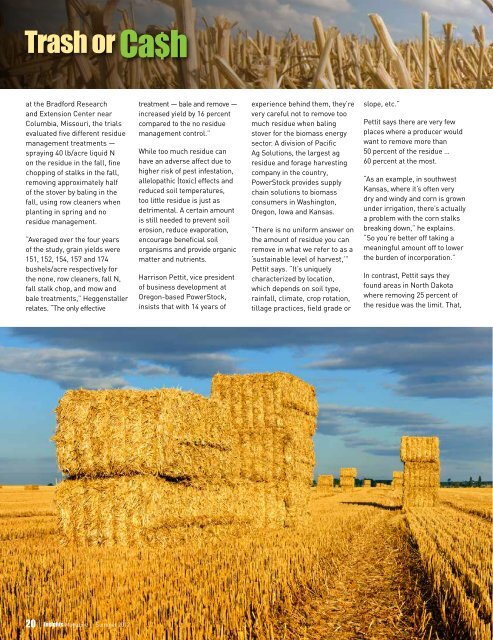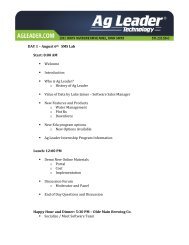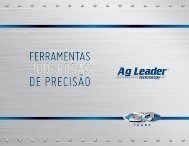You also want an ePaper? Increase the reach of your titles
YUMPU automatically turns print PDFs into web optimized ePapers that Google loves.
Trash or Ca$hat the Bradford Researchand Extension Center nearColumbia, Missouri, the trialsevaluated five different residuemanagement treatments —spraying 40 lb/acre liquid Non the residue in the fall, finechopping of stalks in the fall,removing approximately halfof the stover by baling in thefall, using row cleaners whenplanting in spring and noresidue management.“Averaged over the four yearsof the study, grain yields were151, 152, 154, 157 and 174bushels/acre respectively forthe none, row cleaners, fall N,fall stalk chop, and mow andbale treatments,” Heggenstallerrelates. “The only effectivetreatment — bale and remove —increased yield by 16 percentcompared to the no residuemanagement control.”While too much residue canhave an adverse affect due tohigher risk of pest infestation,allelopathic (toxic) effects andreduced soil temperatures,too little residue is just asdetrimental. A certain amountis still needed to prevent soilerosion, reduce evaporation,encourage beneficial soilorganisms and provide organicmatter and nutrients.Harrison Pettit, vice presidentof business development atOregon-based PowerStock,insists that with 14 years ofexperience behind them, they’revery careful not to remove toomuch residue when balingstover for the biomass energysector. A division of Pacific<strong>Ag</strong> Solutions, the largest agresidue and forage harvestingcompany in the country,PowerStock provides supplychain solutions to biomassconsumers in Washington,Oregon, Iowa and Kansas.“There is no uniform answer onthe amount of residue you canremove in what we refer to as a‘sustainable level of harvest,’”Pettit says. “It’s uniquelycharacterized by location,which depends on soil type,rainfall, climate, crop rotation,tillage practices, field grade orslope, etc.”Pettit says there are very fewplaces where a producer wouldwant to remove more than50 percent of the residue …60 percent at the most.“As an example, in southwestKansas, where it’s often verydry and windy and corn is grownunder irrigation, there’s actuallya problem with the corn stalksbreaking down,” he explains.“So you’re better off taking ameaningful amount off to lowerthe burden of incorporation.”In contrast, Pettit says theyfound areas in North Dakotawhere removing 25 percent ofthe residue was the limit. That,20 | Insights Magazine | Summer 2012
















